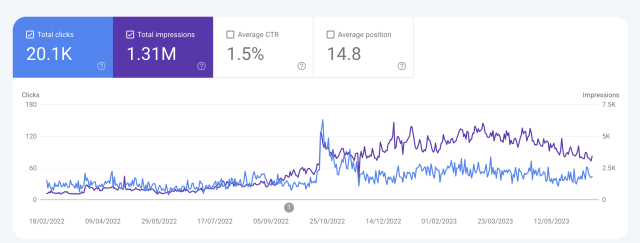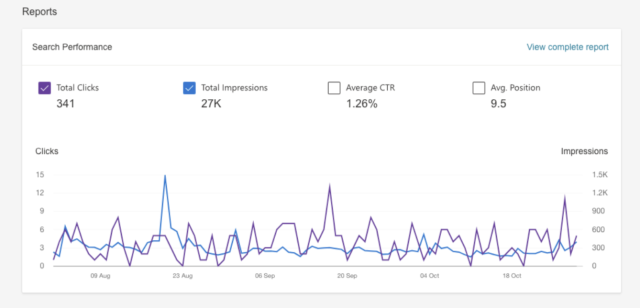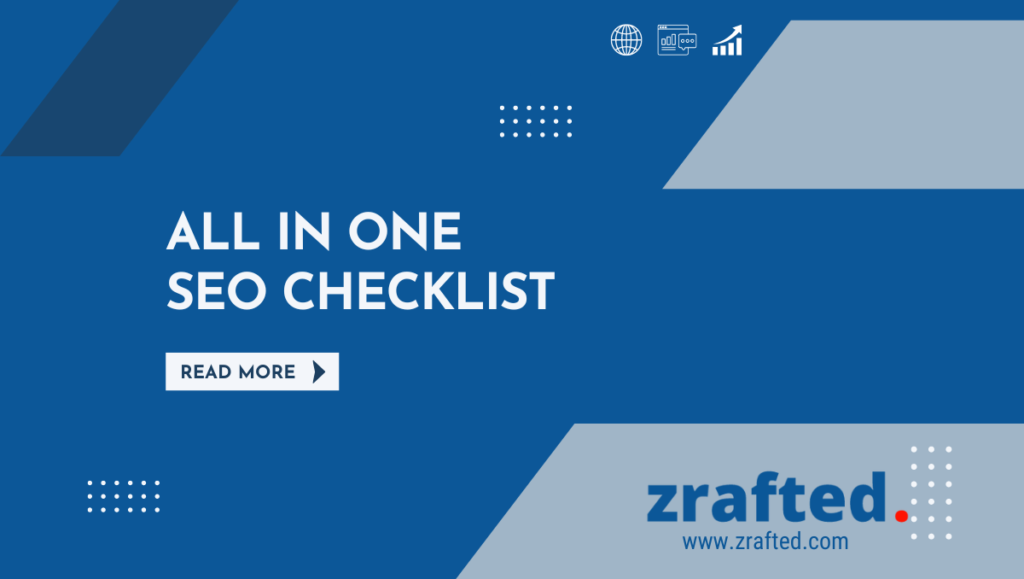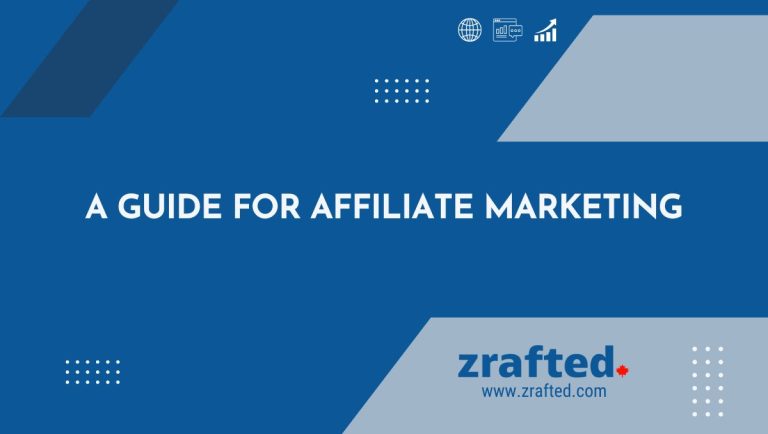This SEO checklist has been composed by our founder, Zain U Din Arshad. We have been following this checklist to grow organic traffic for our website and our clients’.
It works for companies, businesses, affiliate websites, e-commerce websites or anything else.
This list has been working great so far, hence you should follow it too.
The all-in-one SEO checklist is (click on any pointer to navigate to that topic):
- Basic SEO Checklist
- Technical SEO checklist
- Keyword research checklist
- Content checklist
- On-page SEO checklist
- Link building checklist
- Conclusion
Checklist for SEO Basics
These are some of the check points that everyone must focus as main priority. These will add value towards your content to eventually rank higher in Google search results.
1. Set up Google Search Console
Google Search Console is a vital tool if you are looking to work on SEO. This is the tracking tool provided by google itself.
You can do this with search console:
- Organic traffic tracking
- Incoming links
- Ranked keywords
- Traffic demographics and Geography
- Check website for errors
- Submit sitemaps for indexing

2. Setting up Bing Webmaster Tools
Bing’s website master tools is an equivalent of Google search console for the Bing’s search engine.

This is also required if you are looking to rank better on Bing.com search engine. It is a highly used search engine too, therefore you can expect some decent traffic from it.
3. Set up Yandex Webmaster
Yandex is another search engine just like Google and Bing.
4. Set up third party tool for website monitoring
These tools help you track your website’s SEO performance. Some of the most famous ones are Ahrefs, Semrush or Moz.
5. Setup Google Analytics
Google analytics is a free to use tool that will help you track you the source of traffic, what are they interacting with on the website and quantity of visitors.
6. Set up a SEO plugin
SEO plugins help you make SEO related changes on your website easily and add relevant meta tags, sitemaps, robots.txt etc.
These plugins are only for WordPress website. If you need a wordpress website, you can also contact us.
Here are good options for SEO plugins:
Other website CMS don’t need a third party SEO plugin, most of them have SEO things built in. Such as Shopify or Wix.
7. Create a sitemap and submit
Sitemap informs a search engine where it can find useful and important content. This helps it to crawl and index your website quicker.
8. Create a robots.txt file on your website
Robots.txt is a simple plain text file which instructs a search engine crawler on where and where they can not crawl on the website.
It is always recommended to have a robots.txt file to prevent any extra or duplicate pages to be crawled by the crawlers.
In order to check if you have a robots.txt file, type this URL: yourdomain.com/robots.txt. If you see a text file on this URL, you are good. If there is nothing, create one through a robots.txt file generator and upload it to your root directory of the website.
Technical SEO Checklist
Technical SEO can prevent a website from achieving its deserved rankings. Here are some of the basic practices that you must follow for your website.
1.Make sure your website is crawlable
If Google can not index your content property, that will cause indexing issues. In order to prevent this, you should check the Coverage Report in Google Search Console for any errors or warnings.
2. Make sure your website is properly structured (only for new websites)
A user friendly website is important to ensure that search engine crawlers and users can easily navigate through your website. In order to follow this perfectly, make sure you follow a property hierarchy and mind map.
3. Make sure you are using HTTPs
HTTPs is a light weight ranking factor but apart from ranking, It will protect your visitors’ data. It is very important if you are collecting any type of information on your website. If you are using your website for passwords and payment handling, then its a must to have a HTTPs.
Yeah, that’s wrong. HTTPS is not a factor in deciding whether or not to index a page, at all. We do use HTTPS as a light-weight ranking factor, and having HTTPS is great for users. A free certificate from Let’s Encrypt works just as well.
— John Mueller (official) · #StaplerLife (@JohnMu) January 29, 2019
How to know if a website is using HTTPs?
Just look for a padlock behind the URL of that website. Here is an example
4. Avoid multiple locations and addresses of your website
To make sure your website is performing well, your visitors and crawlers must be able to access the website only one one location. For example, www.yourdomain.com.
To double check this for your domain, check the status of your website on httpstatus.io:
If you see your www. and without www. version of your website redirecting to one URL version.
5. Make sure you website loading speed is fast
Page speed is an important ranking factor for desktop (since 2010) and mobile (since 2018).
Its logical, if you find a slow loading website, you will look to find another one. Bounce rate Increases if the website loading speed is slow.
There are two most commonly tools used for website page speed testing
6. Make sure your website pages are mobile friendly
Majority of search engine searches happen on mobile devices. Mobile devices are most commonly used devices nowadays since every other person has a hand held mobile device. So you should have a mobile-friendly website as a priority.
To test your website for mobile friendliness, check with Google’s Mobile-Friendly Test tool.
7. Install Image Compression Plugin or Compress Images Manually
Compressing an image will make It smaller and faster to load. You will get a faster loading speed then. It is an important factor in website’s ranking for Google.
8. Fix Broken Pages
Broken links will negatively impact your rankings. It breaks the flow of authority and link juice across your website.
How to find broken pages?
- Install a suitable plugin
- Start tracking 404 errors
9. Fix Duplicate Content Issues
Duplicate content is a major issue on a website. Duplicate content is a worldwide issue for e-commerce websites.
Keyword Research Checklist
Keyword research is one of the crucial thing in SEO. You can never get traffic if you don’t target the right keywords. You should know what keywords are being searched by the people and then optimise the content according to it to attract traffic, get more clicks and grow your organic traffic. Are you sure your content is optimised on the right keywords?
This checklist for keyword research will help you achieve great results
1. Find a primary keyword your are looking to target
Every page on the website should be targeting a single primary keyword. You can only do that by doing regular keyword research. Every time you have to publish a new page, you need to make sure you are targeting a unique keyword with search volume.
How can you find the best keyword?
Lets take an example to explain it:
For example, you are looking to write a post about best gym supplements. The search intent for this is vast. People would be searching for these types of posts in various ways and you need to make sure you target each way.
People might be searching for best gym supplements like this:
- what is the best gym supplement
- best gym supplements
- best gym supplements near me
- best gym supplements for young people
- best gym supplements to gain weight
- best gym supplements to gain muscle
Are you targeting any of these? No? You should re think about your post.
2. Search Intent Assessment
What is search intent? It is the main reason behind any query performed on a search engine. If your respective page or post is not targeted correctly, you may not receive the deserved rankings on relevant keywords.
How can you assess search intent?
Search for the relevant keyword that you want to target on Google
Check what other top ranked websites have posted. Is it a blog post? A news article, a page or what else?
If you see the top ranking results are blog posts, you may not be able to rank if you are trying to rank your services page. This is how search intent works. You have to look at your competitors and top ranked results, then follow the same.
4. Determine your chances of ranking in Google
This is the ease of ranking on a certain keyword. However, the metric keyword difficulty is a third party metric created by Ahrefs or Moz but this will give you an idea on how hard is to rank on a specific keyword.
Keyword difficulty can be assessed through Ahrefs tool.
However, you should not rely on that completely. You should always work on what motivates you. You will start getting results.
5. Research what people want to know
Lets say someone is searching for “How to grow linked.” You can analyze the search intent from people by looking at ‘People also ask’ section on the google search result. This will give you an idea on what people are actually asking, searching for and what they are looking for.
An example:

Content checklist
Targeting the right keyword should be your priority. All your effort can produce zero results just because your content is not up to the mark. Follow our guidelines to write truly great content for your website
1. Solving Reader’s Problem
Understanding the search intent of your keywords is the initial step that has to be followed to solve reader’s problem. It will tell you what kind of content are people searching for on search engines such as Google or Bing.
The next important step is research, research and research.
Dive deep into your topic, research on it thoroughly. Check what other top ranked pages have on them. Analyse them fully.
Take notes, check hat keywords are being targeted, what are the headings used, what are the internal links and then start writing your content.
2. Write an eye catchy intro
The intro of your content is what will make people stay or leave instantly. The reader tends to analyse your content in the first few seconds by reading your intro.
If you are unable to convince the reader to stay on your page, they will be going back at lightening speed (which will also increase your bounce rate).
A compelling intro will help you solve this problem
A truly good introduction comprises of 3 things:
- Trust building
- Connecting with the reader
- Promising a solution to the reader’s problem
If the reader is not convinced in your intro, he will not be reading your content. Hence you will not be getting any conversions, leads or shares.
3. Create hierarchy using headings
Headings range from H1 to H6 and they exist to create hierarchy in your content. Content with proper headings will break down it into sections and hence easier to read and navigate too.
Long pieces of texts are harder to digest and you will have a hard time retaining readers on your content if its just pieces of text.
Lets take an example of this post, for example, this post that you are reading is divided into sections using H2 and H3 headings.
- Basic SEO Checklist
- Technical SEO checklist
- Keyword research checklist
- Content checklist
- On-page SEO checklist
- Link building checklist
Each section is divided into further subheadings to make it easier and showcase the checklist.
Just imagine this post without any headings. Will you stay and read it? No, I guess.
4. Add Images to Break Up Content
Big pieces of text are a sudden NO.
People will bounce back if they get walled with texts and texts.
Now imagine the same post with images and infographics in it to explain the text. This will be more interesting for the readers.
Visual explanation helps readers understand more. But be sure of one thing, don’t just stuff in Images for the sake of it. Add relevant images that are creative and adds value to the content.
5. Use short sentences and paragraphs
More than half of the US populations read below 8th grade reading level.
Unless you want to target less than half of the population, make your content easy to read and understand.
Use short sentences and paragraphs with easy to understand vocabulary.
6. Add a table of contents
Table of contents is a handy section on a post. It will help the readers to navigate to their desired section easily without having to find what they are looking for in the whole post.
On-page SEO checklist
What is on-page SEO? On-page SEO is optimising the content present on your respective page.
It includes optimising the visual content and the source code.
Follow our checklist to make sure your content is properly optimised.
1. URL should be short and descriptive
Short, descriptive URLs will help the visitors to analyse your content by just looking at the SERPs.
For example,
If we have two pages on the same topic but the URLs look like this:
https://zrafted.com/offered-services
https://zrafted.com/34324
The second URL is not showcasing what the page is about, it just shows random numbers. But the first URL shows the page is about services.
You should always create short and descriptive URL slugs for your posts to attract more traffic. The slug should have your primary keyword in it too. The search engines also appreciate this act.
2. Write a captivating title tag
Similar URLs and title tags show up in Google search results help the searchers completely understand what type of content is on the page.
Always include your targeted keyword in title tags.
Make it something that people would like to click. This will also improve your click-through-rate (CTR).
3. Write a compelling meta description
Meta descriptions are showed approximately 33% of the time in the SERPs.
For the rest, Google will extract the relevant piece of text and display it as your meta description. However it recommended to add a meta tag yourself on the content.
How to write a meta description tag?
- Write according to search intent
- Use an active voice always
- It should be less than 120 words
- Add your primary keywords
- Explain your title
4. Link to relevant resources
You can add internal links on anchor texts inside your content. This will help visitors and crawlers to navigate across your website easily.
Now you might be thinking about the external sources?
Google’s John Mueller says:
But what about external resources?
Linking to other websites is a great way to provide value to your users. Oftentimes, links help users to find out more, to check out your sources and to better understand how your content is relevant to the questions that they have.
John Mueller, Search Advocate Google
But make sure to only add links if its make sense. If you are trying to stuff in links, that might have a negative effect on your rankings.
5. Optimise your images
Images should be properly optimised. ALL OF THEM.
How to optimise images for SEO?
- Compress images to the lowest size possible
- Properly sized images
- Add relevant file names. It should not look like screenshot343.png or image593.jpg. Rename them to descriptive names related to your keyword for example toronto-cn-tower.png.
- Add descriptive alt text. Alt text helps the screen readers to understand what the image is about. It is also shown when the image can not be loaded properly.
6. Add schema markup for rich snippets
The latest SEO trend is to add Schema markups on your content to help search engines understand your content better. It also affects on how your page shows up in the SERPs.
Schema markup has proved to increase click through rates (CTR) and get more visitors to your website.
You can use a plugin on your WordPress website to add schema markup or use schema markup generator to do it.
7. Add Proper Internal Links
Internal links help search engines and users understand what your page is actually about. It also helps them to navigate through the website with ease.
The importance of adding internal links was already discussed in this article but it is always the best bet to add the maximum possible internal links on every new content you are publishing.
Always add internal links to relevant anchor texts.
REMEMBER: Internal linking should not have anchor texts like backlinks.
Link building checklist
Link building, also known as back-linking is one of the important factor of SEO rankings.
I will share some of the personally tested tactics to build links to your content.
1. Replicate your competitors’ links
There is always a chance to get a backlink from a website that is targeting your competitor but not YOU.
Try reaching them out and ask them to link you. Always worth a try.
2. Reclaim lost links
Backlinks can be temporary sometimes. But you can always regain them by contacting the website again
You can find these lost links by using the lost links report in Ahrefs Site Explorer
Sometimes Its easy to regain the lost links.
3. Pursue unlinked mentions
Sometimes a website may mention your brand without linking it to you. You can contact them directly and ask them to link your brand name to your website.
It is a great opportunity to get the unlinked mentioned to link to you.
You can reach out to the author and ask them to link you, that will also make their post look better.
How to find the unlinked mentions? Subscribe to google mentions to find where on the internet is your brand is being mentioned. You will get regular emails about any mentions.
4. Publish guest posts
Guest blogging will help you gain more links to your website if you publish a blog on another website in your niche.
In order to find guest blogging opportunities, you can search for websites that write about topics related to your niche. Reach out to them and ask that you are looking to write an article for their website.
Most of the time it works and you will get a backlink
=================
5. Pitch resource pages
Resource pages are pages that link to resources about a topic.
You can find relevant resource pages using Google search operators like:
- [topic] intitle:resources inurl:resources.html
- [topic] intitle:links inurl: resources.html
- [topic] inurl:.com/resources
- [topic] inurl:resources intitle:resources
It would make sense to pitch an SEO resource for that list.
6. Find people linking to inferior content
If you have a great piece of content. Search for websites linking to similar content like yours but of low quality.
You have a chance to get a link from them because everybody wants to link to great piece of content.
We can always reach out to those authors and suggest them to link to our post instead of the currently linked post.
7. Tell more people about your content
Build relevant audience for your content. Your content is of no use if no one is reading it. You can help it grow if people interested in your topic can find it.
Search for the right people and share your content with them.
Who are the right people for your content?
- Those who are interested
- Those who are ready to link to you
Final Verdict
SEO is a consistent process, it is almost be impossible to include everything in this post. SEO is constantly evolving and is user centric. You will always have to make sure your content is top notch and solve’s the problems of a reader.
You can follow the checklist in this post, make sure you do everything properly. You will be instantly ahead of your competition.
If you are still having problems in anything, feel free to contact our expert SEO team for free consultation.
If you don’t have enough knowledge or time to do all it yourself, you can hire us for your SEO.






